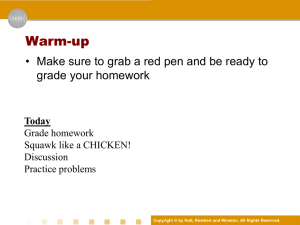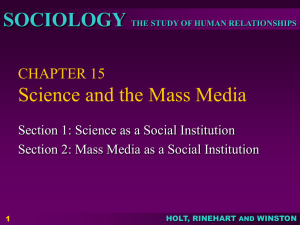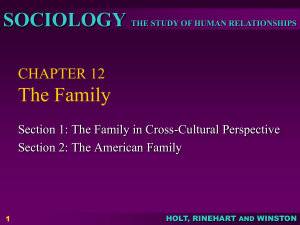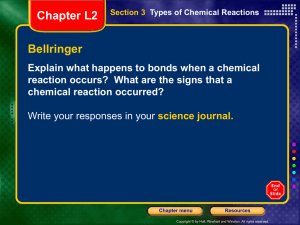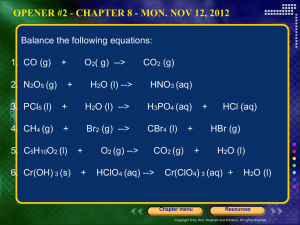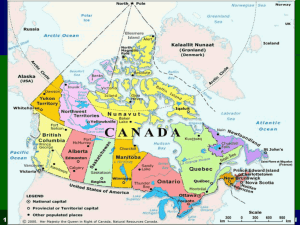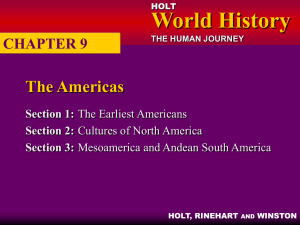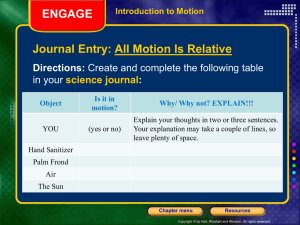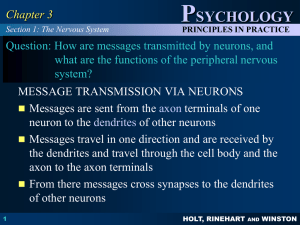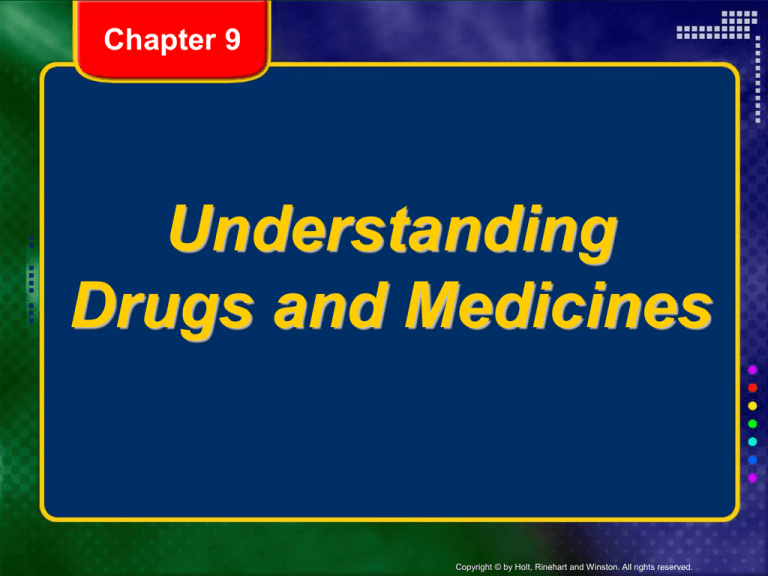
Chapter 9
Understanding
Drugs and Medicines
Copyright © by Holt, Rinehart and Winston. All rights reserved.
1.
2.
3.
4.
5.
6.
7.
ANSWERS
FALSE—minor side
effects of over-thecounter medicines are
common.
TRUE
TRUE
TRUE
TRUE
FALSE—all drugs,
despite their source, are
made of chemicals
FALSE—people can
become addicted
(physically and/or
psychologically to
prescription drugs such
as painkillers.
Copyright © by Holt, Rinehart and Winston. All rights reserved.
Chapter 9
Understanding
Drugs and Medicines
Contents
• Section 1 Drugs
• Section 2 Drugs as Medicines
• Section 3 Drugs and the Brain
Copyright © by Holt, Rinehart and Winston. All rights reserved.
Chapter 9
Section 1
Drugs
Copyright © by Holt, Rinehart and Winston. All rights reserved.
Chapter 9
Section 1 Drugs
VOCAB:
DRUGS: any substance that changes a person’s
physical or psychological state.
MEDICINES: drugs used to cure, prevent, or treat
illness or discomfort.
Good medicines have the following qualities:
• Effectiveness
• Safety
• Minor side effects
Copyright © by Holt, Rinehart and Winston. All rights reserved.
Chapter 9
Section 1 Drugs
VOCAB:
DRUGS OF ABUSE:
1. Taken for their mind-altering effects
2. No medical purpose/benefit
3. Can change the way your brain works in ways that
are unhealthy and dangerous
4. Can change your behavior over time and lead to
addiction and long-term health problems
Copyright © by Holt, Rinehart and Winston. All rights reserved.
Chapter 9
Section 1 Drugs
What Are Drugs?
• All drugs are chemicals.
• All drugs come from one of two sources:
1. Naturals sources, such as plants, animals, or fungi
2. Man-made in Laboratories
Copyright © by Holt, Rinehart and Winston. All rights reserved.
Can you spot the
OTC vs. Rx?
Can you spot the
Natural vs.
Synthetic?
Copyright © by Holt, Rinehart and Winston. All rights reserved.
OTC vs. Rx
OTC
Prescription
Copyright © by Holt, Rinehart and Winston. All rights reserved.
Natural vs. Synthetic
Natural
Synthetic
Copyright © by Holt, Rinehart and Winston. All rights reserved.
Chapter 9
Section 2
Drugs as Medicines
Copyright © by Holt, Rinehart and Winston. All rights reserved.
Chapter 9
Section 1 Drugs
Types of Medicines
• A prescription is a written order from a doctor for a
specific medicine.
• Over-the-counter (OTC) medicines can be bought
without a prescription.
Copyright © by Holt, Rinehart and Winston. All rights reserved.
Drugs can be taken
into the body in the
following ways:
• Implanted pumps
• Inhalation
• Injection
• Transdermal patches
• Ingestion
• Topical application
Copyright © by Holt, Rinehart and Winston. All rights reserved.
Copyright © by Holt, Rinehart and Winston. All rights reserved.
Copyright © by Holt, Rinehart and Winston. All rights reserved.
Chapter 9
Section 2 Drugs as Medicines
Approving Drugs for Medical Use
• The Food and Drug Administration (FDA) was
created by the federal government to control the
safety of food, drugs, and cosmetics in the United
States.
• The FDA uses an approval process for proving a
drug is safe and effective. Some steps include:
1. Chemical or cell-culture testing in laboratories
2. Testing on animals
3. Testing on human volunteers
4. Clinical trials to compare to existing drugs
Copyright © by Holt, Rinehart and Winston. All rights reserved.
Chapter 9
Section 2 Drugs as Medicines
Prescription Medicines (abbreviated: Rx)
• Should only be taken with a doctor’s
recommendation and supervision.
• Taking someone else’s medication or failing to follow
the prescription can be dangerous.
• Can be illegal to possess certain medications without
a prescription.
Copyright © by Holt, Rinehart and Winston. All rights reserved.
Chapter 9
Section 2 Drugs as Medicines
Prescription Medicines
• Prescriptions include the following information:
• Dosage (how much you should take)
• When you should take the medicine
• How often you should take the medicine
• The length of time you should take the
medicine
Copyright © by Holt, Rinehart and Winston. All rights reserved.
Chapter 9
Section 2 Drugs as Medicines
Over-the-Counter (OTC) Medicines
• Most OTC medicines are used for common illnesses,
injuries, and disorders.
• When choosing an OTC:
• Decide what kind of OTC will work for you.
• Decide whether you want a generic or brandname medicine. They often have the same active
ingredients but different inactive ingredients.
• Read the labels.
•Long-term use of OTC medicines can cover up more
serious problems.
•If symptoms persist, consult a doctor.
Copyright © by Holt, Rinehart and Winston. All rights reserved.
Copyright © by Holt, Rinehart and Winston. All rights reserved.
Chapter 9
Section 2 Drugs as Medicines
Herbal remedies and dietary supplements
• Do not have to be approved by the FDA.
• May be ineffective or dangerous
Copyright © by Holt, Rinehart and Winston. All rights reserved.
Chapter 9
Section 2 Drugs as Medicines
Side Effects of Medicines
• Allergic reactions are the most serious risks to
taking medicines.
• Symptoms of anaphylactic shock include:
• Itching all over the body
• Swelling, especially in the mouth or throat
• Wheezing or difficulty breathing
• Pounding heartbeat
• Fainting and unconsciousness
• Possible death
Copyright © by Holt, Rinehart and Winston. All rights reserved.
Drug Interactions Video
• http://youtu.be/S8QHQlzxbHQ
Copyright © by Holt, Rinehart and Winston. All rights reserved.
Chapter 9
Section 2 Drugs as Medicines
Side Effects of Medicines
• All medicines have potential side effects.
• Drug interactions / reactions
• MULTIPLIER EFFECT (increase or decrease
the effect of one of the substances
• occur when a drug reacts with another drug,
food, or dietary supplement
• Labels on OTC packages describe possible
drug interactions and potential side effects.
http://www.youtube.com/watch?v=S8QHQlz
xbHQ
Copyright © by Holt, Rinehart and Winston. All rights reserved.
Chapter 9
Section 2 Drugs as Medicines
Using Medicines Wisely
1. ASK YOUR DOCTOR QUESTIONS!
2. Make yourself part of your own healthcare
team.
3. Learn the facts about any medicine you take.
4. Listen to your body.
5. It’s not always safe to suddenly stop taking a
drug.
6. Speak up and enlist your parents’ help.
Copyright © by Holt, Rinehart and Winston. All rights reserved.
Chapter 9
Section 3
Drugs and the Brain
http://www.youtube.com/watch?v=CGm5zkYCHkQ&list=PLoRCED6IleVk
G4Fv9SmeeH_xUEtpx1CaQ&index=1
Copyright © by Holt, Rinehart and Winston. All rights reserved.
Chapter 9
Section 3 Drugs and the Brain
How Drugs Affect the Brain
• Information processing in the brain takes place at the
connections between neurons, called synapses
• Signals are passed across synapses by chemicals
called neurotransmitters
• Some drugs affect the way neurons
communicate by:
• acting like neurotransmitters
• blocking neurotransmitters
• changing the amount of neurotransmitters
• These changes can affect our moods and
emotions
Copyright © by Holt, Rinehart and Winston. All rights reserved.
Copyright © by Holt, Rinehart and Winston. All rights reserved.
Chapter 9
Section 3 Drugs and the Brain
The Path to Addiction
• ADDICTION: a condition in which a person can
no longer control his or her drug use.
• Most drugs of abuse activate the BRAIN REWARD
SYSTEM, which releases chemicals that give
pleasure.
• Pleasure alone does not cause addiction
• People who become addicts usually start by
experimenting, then more regular use leads to a
series of changes on the path to addiction.
Copyright © by Holt, Rinehart and Winston. All rights reserved.
Copyright © by Holt, Rinehart and Winston. All rights reserved.
Chapter 9
Section 3 Drugs and the Brain
Addiction is a Treatable Disease
• WITHDRAWAL: the symptoms that occur when a
drug user stops using a drug.
• Stopping drug use can be very difficult because the
withdrawal symptoms are often very unpleasant.
• Drug addiction is a brain disorder, and it is treatable.
• Most communities offer a variety of treatment programs.
• The best way to avoid addiction is to avoid drugs of
abuse altogether.
Copyright © by Holt, Rinehart and Winston. All rights reserved.
End of Chapter 9
Copyright © by Holt, Rinehart and Winston. All rights reserved.

